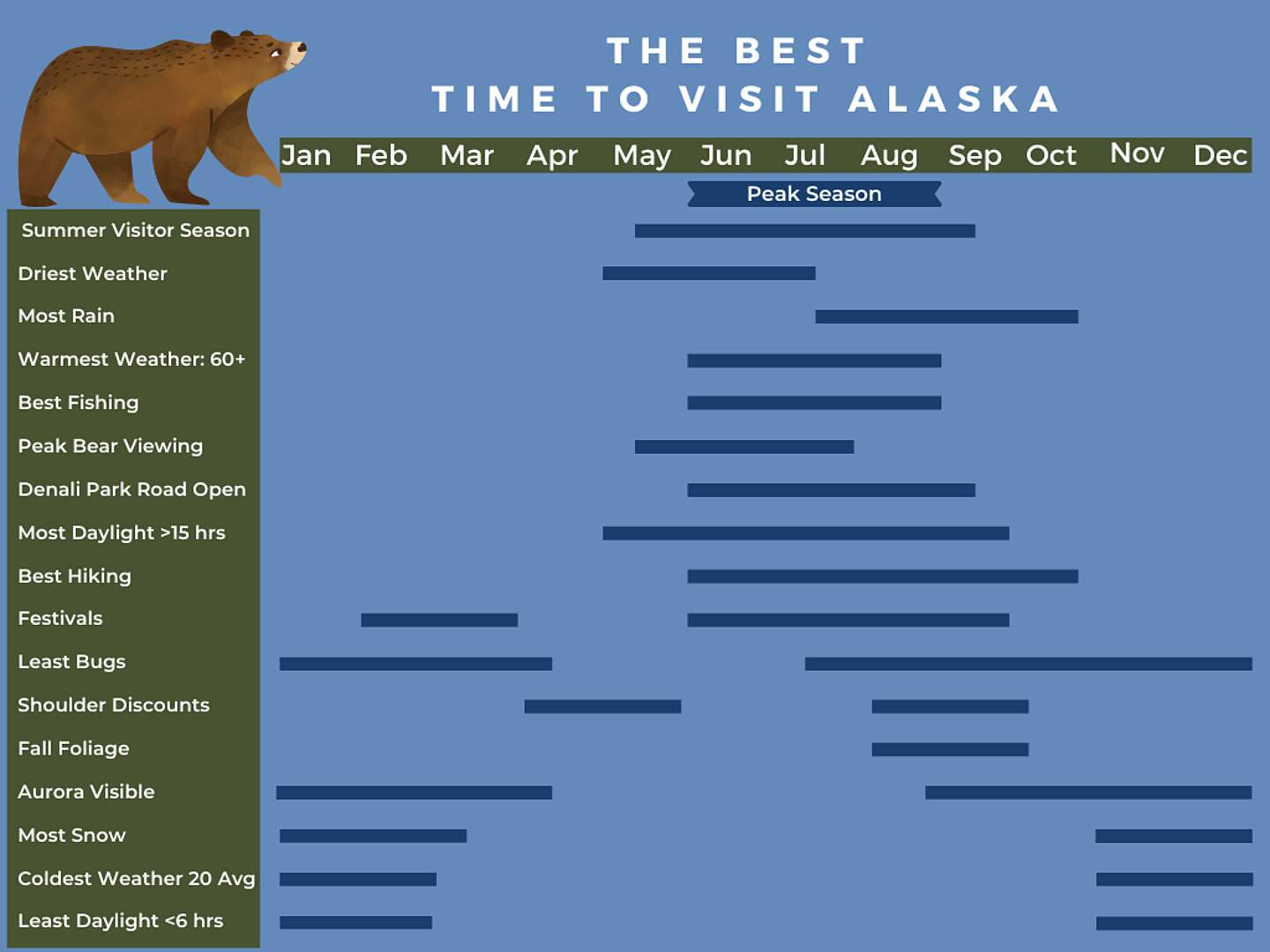Alaska, the land of the midnight sun and breathtaking wilderness, offers a unique travel experience. Deciding when to visit this vast and stunning state is crucial to making the most of your trip. While Alaska boasts attractions year-round, the Best Time To Travel To Alaska for most travelers is during the summer months, specifically between mid-May and mid-September. This period offers the most favorable conditions for exploring Alaska’s iconic landscapes and wildlife.
Why Summer is Alaska’s Peak Season
The summer season, roughly from May 10th to September 15th, is when Alaska truly comes alive. During these months, you can expect temperatures ranging from a comfortable 60°F to the low 70s°F (15°C to 23°C). This pleasant weather is accompanied by incredibly long daylight hours, often stretching to 16-24 hours depending on your location. This abundance of daylight allows for extended exploration and adventure. Summer also marks a period of natural exuberance, with leaves and flowers in full bloom, rivers rushing with meltwater, and wildlife at its most active and visible.
 Infographic calendar detailing the best time to visit Alaska, highlighting peak season for optimal weather, wildlife, and activities
Infographic calendar detailing the best time to visit Alaska, highlighting peak season for optimal weather, wildlife, and activities
For the quintessential Alaskan summer experience, consider targeting your visit between June 15th and July 15th. This period represents the height of summer, offering the warmest and driest conditions, and a vibrant atmosphere buzzing with energy. It’s when the Alaskan summer is at its absolute best, making it the most popular time for visitors.
Key Considerations for Summer Travel in Alaska
Traveling to Alaska in the summer offers numerous advantages, but here’s a deeper dive into what you can expect:
Temperature and Weather Conditions
Summer in Alaska is generally mild and comfortable. Daytime temperatures typically fluctuate between 60°F and 80°F (15°C to 27°C). Nights are refreshingly cool, with temperatures dipping into the 40s and 50s°F (4°C to 15°C). It’s worth noting that May and September tend to be slightly cooler, approximately 5°-10°F lower than the peak summer months. Interestingly, May is often the driest month, with around a 25% chance of rain on any given day. As summer progresses towards September, the likelihood of rain increases to about 50%. Packing layers is essential to adapt to these varying conditions.
Daylight Hours: Embracing the Midnight Sun
Alaska in the summer is famed for its extended daylight. The summer solstice, around June 21st, marks the longest day of the year. Anchorage experiences around 19 hours of daylight, Southeast Alaska around 18 hours, and Fairbanks an astonishing 22 hours. From late May to late July, it remains light almost throughout the night, and for a month on either side of this peak, daylight extends past 10 pm. These long days, often referred to as the “Midnight Sun,” maximize your time for activities and exploration, allowing you to pack more into each day.
Wildlife Viewing Opportunities
Summer is arguably the prime time for Alaska wildlife viewing. From May to September, wildlife is generally more active and visible. Bear viewing, particularly fly-in bear viewing excursions, commences in May and peaks in July when salmon runs are at their height. Moose can be spotted year-round, but summer offers pleasant conditions for sightings. Whale watching is also exceptional during summer. Gray whales migrate through Alaskan waters in March and April, while humpback whales are prevalent from May to September. Orcas are residents and can be seen throughout the year. Summer provides the most comfortable and accessible conditions for witnessing Alaska’s diverse wildlife.
Fishing Adventures
For anglers, fishing in Alaska during the summer is unparalleled. Summer is when various salmon species return to spawn, making it a fantastic time for salmon fishing. Halibut and other fish species are also abundant and actively feeding throughout the summer months. Whether you’re interested in saltwater or freshwater fishing, guided fishing charters and opportunities abound across Alaska during the summer.
Hiking and Outdoor Activities
Summer unlocks Alaska’s vast network of hiking trails. Near Anchorage, lower elevation trails typically become snow-free by May, with mountain trails clearing by early June. Hiking conditions remain excellent until mid-October. For regions closer to the Arctic, it’s advisable to wait until late June for trails to be clear of snow. Summer’s mild temperatures and long daylight hours are ideal for hiking, backpacking, kayaking, and a wide range of outdoor pursuits.
Mosquito Season
It’s important to be aware of mosquitoes in Alaska during the summer. These insects typically emerge in early June and diminish by early August. While mosquito presence can vary depending on location and weather conditions, being prepared with insect repellent is recommended, especially during June and July.
Summer and the Aurora Borealis
The Northern Lights, or Aurora Borealis, are generally not visible during the peak summer months in Alaska because the nights are not dark enough. If seeing the Northern Lights in Alaska is a priority alongside enjoying summer activities, consider visiting between August 15th and September 15th. During this late summer period, you might have a chance to experience both the tail end of summer and the beginning of the aurora season as nights start to lengthen.
Transition to Fall Foliage
As summer nears its end, Alaska transitions into a stunning fall landscape. Fall foliage typically peaks from mid-August to mid-September, creating vibrant displays of color, particularly in the tundra above the tree line. This late summer to early fall period can be an excellent time to visit, offering a combination of pleasant weather, fewer crowds, and the chance to witness autumn colors.
 Questions? Let
Questions? Let
Explore Alaska Further
While summer is widely considered the best time to visit Alaska, each season offers its unique charm. If you’re curious about exploring Alaska during other times of the year or have more questions about planning your summer trip, don’t hesitate to reach out to local experts for personalized advice and to ensure you make the most of your Alaskan adventure.
